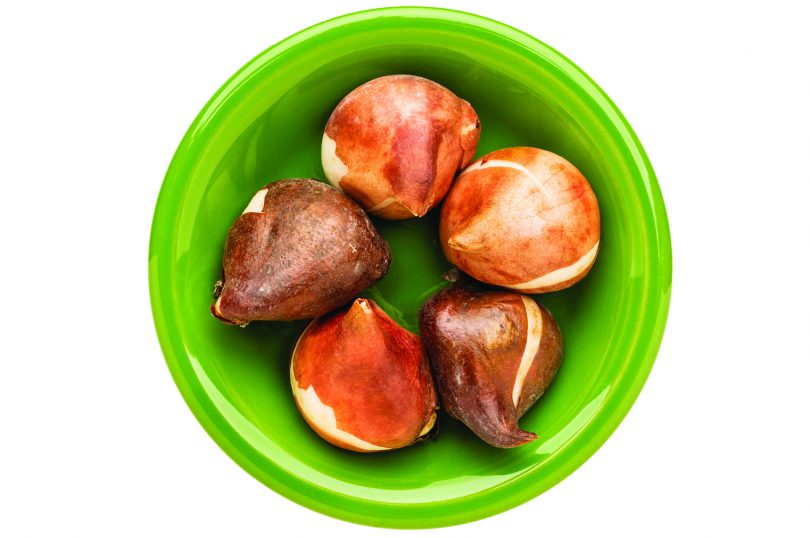By Vicki Spencer, Master Gardener
If you are an experienced gardener, you probably discovered that the secret to cultivating a beautiful garden involves time, hard work and patience. Weekend gardeners face a greater challenge with all the chores that come with gardening. Patience is important because you can’t do everything at once; but patience pays off. You can continue adding to your garden design for years to come, and that is half the fun.
By the time fall arrives, you had some time to observe gaps that you want to fill in. If you think back, you can recall how anxious you were to start gardening in the springtime after a few warm days tempted you. But the soil was probably too cool to cultivate and nighttime temperatures were too unpredictable to guarantee new plants would survive. Now is the time to get a jump start on the season by filling in those bare spots with spring-blooming bulbs.
Bulbs are living buds whose embryos contain all the nutrients needed to produce the first year’s blossoms. When you plant bulbs in the fall, you are allowing them to “winter over” and focus their energy on root growth. This leads to more abundant blossoms compared to waiting until spring to plant. (Note that not all the bulbs discussed in this article are true bulbs. Some are corms, rhizomes and tubers, but it is common practice to refer to all of them as bulbs.)
Most Colorado gardeners begin planning spring bulb plantings in August or September, with the goal of putting bulbs in the ground by mid to late September — a month before the first frost — or when nighttime temperatures range from 40 to 60 degrees. This, of course, is hard to predict, but Mother Nature is forgiving if we have an early frost. On the Front Range, I often wait until mid to late October before getting around to separating and transplanting bulbs, and they do just fine in the spring. If you cannot plant your mail-order bulbs when they first arrive, open the package to make sure they are healthy, then leave them in the bag (preferably mesh) and store for up to month in a cool, dry place.
Bulbs can be planted almost anywhere as long as the soil drains well. To prepare your bed, loosen the soil about 8 inches deep. If it is not an established bed and you have not tested your soil, now would be a good time. The optimum pH is 6 to 7. For new beds in Colorado’s clay soils, you’ll want to add organic matter, such as compost or peat.
You should also consider light requirements. Since early spring bulbs bloom before most trees leaf out, you can plant them along the borders under shade trees. Also, if you want your flowers to bloom throughout the spring, you should consider planting some on southern slopes for early blooming and some along northern slopes and in valleys for later blooming.
The rule of thumb for planting is two to three times as deep as the bulb is tall, but I recommend following the planting instructions when provided. (Note that this rule does not apply to all bulbs, including summer bulbs, so you may want to ask your garden supplier or county Extension office for advice.)
• Generally, big bulbs should be planted 8 inches deep and smaller ones 5 inches deep.
• Plant the pointed side up and the root side down. If the distinction is not obvious, place sideways in the soil.
• Bulbs are more striking when grown in clusters, so dig a hole wide enough to plant several bulbs of the same color and variety a few inches apart from one another.
• Once the bulbs are in place, gently press the soil around the bulbs to keep them secure.
• Water and cover with garden soil and mulch.
When people ask what bulbs to plant, I suggest hardy bulbs that can survive Colorado’s lower winter temperatures. They can be left in the ground year-round and are low maintenance. If you are looking for a deer or rabbit resistant flower and like to experiment with unusual blossoms, try planting butterfly daffodil bulbs. The American Meadows website features an elegant “Apricot Whirl” whose double white blooms are accented with apricot-peach centers. Reaching 14 to 26 inches at maturity, these daffodils provide a lovely contrast when planted in front of purple Dutch irises. You can view a splendid variety of Dutch irises at hollandbulbfarms.com.
Although this article focuses on spring-blooming bulbs, you can plant some summer- and fall-blooming bulbs in the fall, too. For a garden that blooms all season, plant early blooming snowdrops, crocus and scilla, followed by daffodils, tulips and hyacinths, which have a wide-ranging bloom time. Finally, add alliums, dahlias, cannas and gladiolas for flowers that will take you through the season. All these bulbs should be considered a staple in any Colorado garden because they grow so easily. To get some ideas for starting your fall plantings, visit bluestoneperennials.com.

